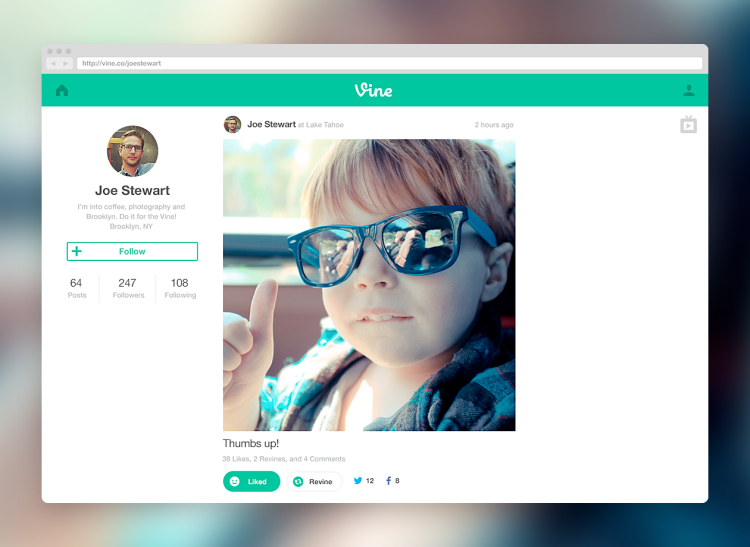YouTube may be the leader in short-form online video today, but video fans are increasingly following video creators all over the Internet and across social platforms. Ask any video star or multi-channel network, and they will tell you their content has a massive following not only on video-centric platforms like YouTube, Vine, and Twitch, but also on Twitter, Facebook, Instagram, Pinterest, Snapchat, and others. Being on multiple platforms is the norm.
So how can video creators best prepare their content and process for this fragmented world? Multi-platform mastery requires a unique blend of creative content, planning, experimentation, real-time iteration, and engagement with fans. It also means making more content beyond your video. Multiple edits for preview clips, outtakes, one-liners, action shots, stills, and even GIFs and memes are used to carry your story across platforms.
General tips
Establish accounts on every social and video platform where you may have fans. Experiment with publishing and building community on each platform. The platforms may not pay out directly today, but the landscape is changing quickly and they may pay out tomorrow or be important to landing a big brand deal.
Think about creating six to 12 additional pieces of content for every video you publish. You should share these on social before and after a video release. This is a way to extend your storytelling, keep top of mind with your audience, and make sure all your fans catch your content in fast-moving feeds. You can derive these stills and clips from your main video.
Outtakes, one-liners, and stills are a great lead-up on social media to remind your audience a video will be published soon.
Social media platforms disseminate information to fans quickly, so tightly edited preview clips published on those platforms are powerful reminders that you have just released new content on YouTube.
Sharing GIFs, memes, and one-liners related to your video on social in the days and weeks after you publish a video is a great way to keep content alive and catch fans who may have missed the video release.
Acknowledging top fans and comments is another great way to keep your community active when you don’t have new videos to share. If you don’t have much time, start by engaging with your most influential fans on each platform — fans who have the biggest social following and fans who comment the most.
Each platform has its own rhythm for your fan base. Looking at platform insights and analytics or using a third-party tool for analytics can help you understand what content works, what format to use, when to publish, and how to tag.
Just as you should regularly publish and respond to comments on YouTube, you should also regularly publish and engage on the social platforms. Establish a daily, weekly, and monthly workflow for publishing, interacting with fans, and looking at insights.
Social platform-specific tips
- Vine: Create six-second clips from your videos and share them to Vine to raise awareness for a new YouTube video and keep it on your fans’ minds. Both single cuts and composite edits work. One-liners and action scenes are often popular. Experiment with different edits over several days to find what works best for your audience.
- Instagram: Similar to Vine, 15-second preview clips from your videos quickly connect with your fans on Instagram. The Instagram length lends itself well to multiple scene edits.
- Twitter: Massive video sharing happens on Twitter, but it’s hard to see from your Twitter account, because many fans cut and paste a YouTube link without including handles or hashtags. For this reason an average of 80 percent of tweets about your videos are not surfaced in Twitter. Searching for your video links will often expose more tweets and more fans. But you need to be careful, because there are multiple links for every YouTube video, so keeping on top of search for all the links to your video can get tedious. For publishing, Twitter-native video is being rolled out, and it’s likely to be a good place to share 30-second edits of your videos.
- Facebook: Facebook’s algorithm significantly prioritizes Facebook video over YouTube and external players. To maximize Facebook reach, upload videos to the native Facebook player. You can use similar preview clips or one-liner clips to those you use for Vine and Instagram but with no limit on length. In the description section of each Facebook native video preview clip you share, link out to the full length video on YouTube. Once you perfect your process, this strategy balances Facebook native player reach with YouTube’s ability to monetize pre-roll.
The bottom line is that being a modern video star means more platforms, formats, and ways of engaging audience. Platforms are not consolidating, they’re proliferating and serving different functions and providing different opportunities. Each creator needs to find the right mix of media, formats, and platforms to connect with their audience and the right tools to manage the complexity.
Today online video is so much more than just video. Leading video creators are building community and publishing multiple types of content on multiple platforms. Tomorrow, running and monetizing from a multi-platform video business will be the norm. Get ready for the multi-platform, multi-format video future.
Juan Bruce is chief executive and a cofounder of Epoxy, a technology company for creators to distribute videos, engage with fans, and measure the true reach of their content across the social web.
VentureBeat's mission is to be a digital town square for technical decision-makers to gain knowledge about transformative enterprise technology and transact. Learn More

